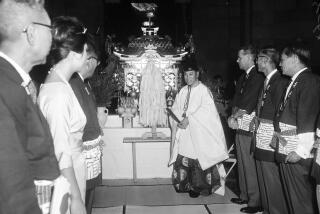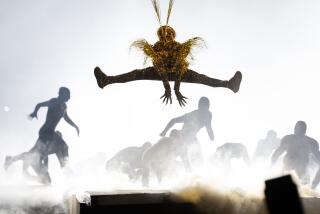THE SEOUL GAMES / THE FINAL DAY : Korea Captures the Moment, Says Seoul Long
SEOUL — The closing ceremony was a choreography of Korean culture: Cymbal Dances, Fan Dances, Lantern Dances. A Bridge Created by Magpies. Parting Ships. Complicated affairs with as many 750 costumed dancers at a time, twirling ribbons (from their hats!) and carrying banners, filling the Olympic Stadium floor with color and movement.
Yet what do you remember when it is all done? You remember that great global conga line, the entry of athletes. Afghanistan to Zimbabwe, and Qatar in between.
Here’s a delegation in blue blazers and straw skimmers. The Americans wear satin jump suits and are in typical disarray. The Soviets--we missed them in ‘84--parade in white suits, shoes and cockeyed gangster hats. Those dandies! The Africans wear billowing robes of wild color, the Australians yellow greatcoats and safari hats. The host Koreans, last in, wear soft blue blazers and white slacks and march in a line.
They came and they came Sunday, erupting from a tunnel and overtaking the stately flag bearers, lapping each other by turns, reversing field, causing a happy confusion and disorder. Each to his own exuberance. The athletes carried one another on their shoulders. Took pictures. Threw stuff--little flags mostly--into the crowd. Some U.S. athletes collapsed in the infield; an overhead camera revealed their self-congratulations, “USA!”
So it always is at these Olympics, only this time more so. The most universal Games in history. Botswana. Gabon, Vanuatu. Countries of no particular size or athletic distinction. East Germany, too. Countries back in the Olympic fold after one political snub or another. Not countries, of course, but their athletes.
It’s the athletes you remember, reconvened for that long sigh of relief, the closing ceremony. Whereas the opening ceremony are highfalutin in their promises and purposes, a grimace of expectations really, it’s the closing ceremony that offer the lasting benediction: Once more we have survived the Games’ intrigues, scandals and small stupidities. Nothing really important went wrong, a lot of things went right.
Let’s dance.
The Olympic organizers, these particular ones, were mindful that it is an unfortunate party that does not allow for spontaneity. Their planning was obviously meticulous. The production numbers--750 kids?--went off without a hitch and if they didn’t always entertain they always reminded you of the Koreans’ cultural pride. And, of course, many of them did entertain. At one point the lights were dimmed and, arising from a floor of smoke, a giant foil balloon hovered in the sky, pinned by spotlights. The rim of the infield and the rim of the stadium heights erupted in sparklers. The 70,000 spectators, and even the athletes, collectively gasped.
Yet this precision accommodated play, which is a good thing given 161 nations worth of inherent rowdiness. Park Seh Jik, president of the Seoul Olympic Organizing Committee, and Juan Antonio Samaranch, President of the International Olympic Committee, shared speeches from a small platform. And then they delivered the Olympic flag to Pascual Maragall, mayor of Barcelona, host of the 1992 Summer Games.
And somehow the athletes, who had been contained in the infield, materialized at the platform, carrying their own nation’s flags. Others, seeing this, raced back for their flags and returned. And through no apparent plan, they mounted the small platform and overwhelmed the officials, turning that stage into the most colorful bouquet you ever saw, a pincushion of nations. The athletes couldn’t help themselves, but it was all right.
Any closing ceremony has its formalities. One, of course, is the gradual dying of the Olympic flame, a torch that had blazed over triumph and disappointment for 16 days. It was done in the darkness of the stadium and it was apparent just how much light the giant torch threw off. You could almost read by it. But the fire slowly died in the darkness, a few flames licking the night sky until all was black.
Lately, two Olympics anyhow, there has been another formality. The fan participation in a light show. Sunday the spectators withdrew a lantern from a packet that was issued upon entry and produced a red-and-blue light, a carpet of it when seen from across the stadium. Sections of far bleachers had special lights and if you strained you could make out “Good By” in the opposite stands. This was performed against the musical backdrop of a ghostly chorale.
A final requirement of closing ceremony is the fireworks display. This one boomed outside all four sides of the stadium, bright and concussive and forever. Perhaps like the Games themselves, the fireworks were loud, brilliant and at times obnoxious. Also, like the Olympics, you were sorry when the they ended.
Finally, they did, fireworks and Olympics. As the blue-and-white tracery faded into dull streams of smoke, just a light dusting of the heavens, you could see the athletes holding hands on the stadium floor, forming long lines and snaking about, complex curlicues, stitching their joy into Olympic history: Jordan, Malaysia, Great Britain. Bulgaria, Maldives and Romania. Czechoslovakia and Sri Lanka. Tonga, too.
More to Read
Go beyond the scoreboard
Get the latest on L.A.'s teams in the daily Sports Report newsletter.
You may occasionally receive promotional content from the Los Angeles Times.






